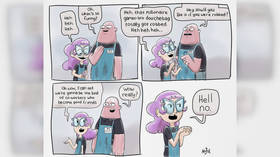Los Angeles ambulance crews, stretched thin by Covid-19 surge, told NOT TO TRANSPORT PATIENTS expected to die
Ambulance crews in Los Angeles, which has become ‘ground zero’ for the latest surge in US Covid-19 cases, have been ordered to refuse transport for people likely to die, conserving resources for those with better chances.
Due to the pandemic’s impact on hospitals, “adult patients in blunt traumatic and nontraumatic out-of-hospital cardiac arrest shall not be transported if return of spontaneous circulation is not achieved in the field,” the Los Angeles County Emergency Medical Services (EMS) Agency said in a memo on Monday. The policy applies to all types of patients, from those suffering a heart attack or stroke to accident victims.
Also on rt.com LA hospital workers balk at taking Covid-19 vaccine, media says they're somehow not ‘IN TUNE’ with science & Trump is to blamePatients in traumatic cardiac arrest who meet certain criteria, such as showing no return of spontaneous circulation or shockable rhythm identified during resuscitation efforts, “shall be determined dead on scene and not transported,” the directive said. For patients in nontraumatic cardiac arrest who don’t meet the so-called Reference 814 criteria, on-scene resuscitation efforts should continue for up to 20 minutes “or until futility is reached.”
The EMS Agency also ordered new restrictions on how much oxygen can be administered to patients in various situations. For instance, “EMS should only administer supplemental oxygen to patients with oxygen saturation below 90 percent.” All of the changes were made effective immediately.
Also on rt.com As a doctor, I’ve studied the data swirling around this perplexing Covid virus. One stark truth stands out: lockdowns don’t workLos Angeles County has tallied nearly 11,000 Covid-19 deaths and currently has about 7,700 patients hospitalized with the virus, according to public health data. County officials warned on Monday that weekly deaths may rise to 1,000 if current trends continue. There were a record 262 deaths reported last Wednesday alone, and the county’s cumulative number of confirmed cases doubled to 800,000 between the end of November and January 2.
COVID-19 Daily Update:January 4, 2021New Cases: 9,142 (827,498 to date)New Deaths: 77 (10,850 to date)Current Hospitalizations: 7,697The number of new cases and deaths reported today reflects reporting delays over the New Year's holiday weekend. pic.twitter.com/e1Zdmju5iv
— LA Public Health (@lapublichealth) January 5, 2021
The National Guard has been called in to help county workers move corpses from overcrowded hospital morgues. “There have been some unfortunate outcomes for patients in hospitals and ambulances across the county who couldn’t be offloaded into an emergency department in a timely manner,” the county’s Health Services Director Dr. Christina Ghaly told the Los Angeles Times.
Also on rt.com American talk-show legend Larry King hospitalized in Los Angeles after contracting Covid-19Many hospitals are reportedly diverting ambulances to other providers, while some arriving patients are put into waiting rooms. In some cases, intensive care is being carried out in hallways and recovery areas.
Epidemiologist Dr. Eric Feigl-Ding called the new ambulance policies “next-level bad.” He added, “This radical change in ambulance rules means if an EMT paramedic cannot resuscitate a heartbeat, a patient will not be transported to any hospital in Los Angeles. This is worse than rationing care.”
⚠️NEXT LEVEL BAD—this radical change in ambulance 🚑 rules means if an EMT paramedic cannot resuscitate a heart beat, a patient will not be transported to any hospital in Los Angeles.➡️This is worse than rationing 🏥 care. We have reached this. #COVID19pic.twitter.com/DllJMTKdWT
— Eric Feigl-Ding (@DrEricDing) December 31, 2020
Los Angeles hospitals are “on the brink of catastrophe,” UN Goodwill Ambassador and journalist Isha Sesay reported on Twitter. “From my apartment, all I hear is ambulance sirens, all day long.”
Los Angeles hospitals are “on the brink of catastrophe” according to a top official. Health care workers describe the scene in hospitals as a “war zone.” From my apartment all I hear is ambulance sirens. All day long. Please, please, stay home everyone. Wear a mask.
— Isha Sesay (@IshaSesay) January 2, 2021
Like this story? Share it with a friend!













